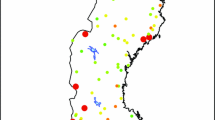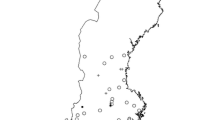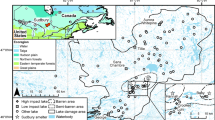Abstract
In response to reduced sulphur emissions, there has been a large decrease in sulphate (\( {\text{SO}}^{{2 - }}_{4} \); −0.97 μeq l−1 year−1) and hydrogen (−1.18 μeq l−1 year−1) ion concentration in bulk precipitation between 1980 and 2000 at Plastic Lake in central Ontario. The benefit of this large reduction in \( {\text{SO}}^{{2 - }}_{4} \) deposition on stream water chemistry was assessed using the gauged outflow from a conifer-forested catchment (PC1; 23.3 ha), which is influenced by a small wetland located immediately upstream of the outflow. Sulphate concentrations declined, but not significantly due to large inter-annual variation in \( {\text{SO}}^{{2 - }}_{4} \) concentration. Between 1980 and 2000, there were significant increases in dissolved organic carbon, ammonium and potassium concentration likely reflecting increased mineralisation in the wetland. Calcium concentrations in PC1 decreased during the two decade period (−2.24 μeq l−1 year−1), as a consequence there was no improvement in stream pH and the Ca:Al ratio in PC1 continued to decline. A similar response was noted in an upland-draining sub-catchment of PC1-08 that has been monitored since 1987. Despite large reductions in \( {\text{SO}}^{{2 - }}_{4} \) deposition and almost complete retention of nitrogen in soil, there has been no improvement (in terms of pH) in stream water at PC1 due to a combination of soil acidification and climatic (droughts, increased mineralisation) perturbations.


Similar content being viewed by others
References
Clark, J. M., Chapman, P. J., Adamson, J. K., & Lane, S. N. (2005). Influence of drought-induced acidification on the mobility of dissolved organic carbon in peat soils. Global Change Biology, 11, 791–809.
Cronan, C. S., & Grigal, D. F. (1995). Use of calcium/aluminum ratios as indicators of stress in forest ecosystems. Journal of Environmental Quality, 24, 209–226.
Driscoll, C. T., Driscoll, K. M., Roy, K. M., & Mitchell, M. J. (2003). Chemical response of lakes in the Adirondack Region of New York to declines in acidic deposition. Environmental Science and Technology, 37, 2036–2042.
Eimers, M. C., & Dillon, P. J. (2002). Climate effects on sulphate flux from forested catchments in south-central Ontario. Biogeochemistry, 61, 337–355.
Evans, C. D., Freeman, C., Monteith, D. T., Reynolds, B., & Fenner, N. (2002). Climate change – terrestrial export of organic carbon: Communication arising. Nature, 415, 862.
Evans, C. D., Monteith, D. T., & Cooper, D. M. (2005). Long term increases in surface water dissolved organic carbon, possible causes and environmental impacts. Environmental Pollution, 137, 55–71.
Hedin, L. O., Granat, L., Likens, G. E., Buishand, T. A., Galloway, J. N., Butler, T. J., et al. (1994). Steep declines in atmospheric base cations in regions of North America. Nature, 367, 351–354.
Hejzlar, J., Dubrovsky, M., Buchtele, J., & Ruzicka, M. (2003). The apparent and potential effects of climate change on the inferred concentration of dissolved organic matter in a temperate stream (the Malse River, South Bohemia). Science of the Total Environment, 310, 143–152.
Hirsch, R. M., & Slack, J. R. (1984). A nonparametric trend test for seasonal data with serial dependence. Water Resources Research, 20, 727–732.
Hutchinson, B. A., Scott, L. D., Futter, M. N., & Morgan, A. (1994). Hydrology data for lakes and catchments in Muskoka/Haliburton (1980–1992). Ontario Ministry of Environment data report DR93/5, ISBN 0-7778-2535-X PIBS 3017 17pp.
IPCC (2001). Third Assessment Report: Climate Change 2001.
Jeffries, D. S., Clair, T. C., Couture, S., Dillon, P. J., Dupont, J., Keller, W., et al. (2003). Assessing the recovery of lakes in southeastern Canada from the effects of acid deposition. Ambio, 32, 176–182.
Jeffries, D. S., & Ouimet, R. (2005). Critical loads: Are they being exceeded? In H. A. Morrison (Ed.), Canadian acid deposition science assessment. Canada: Environment Canada.
Kirchner, J. W., & Lydersen, E. (1995). Base cation depletion and potential long-term acidification of Norwegian catchments. Environmental Science and Technology, 29, 1953–1960.
Krug, E. C., & Frink, C. R. (1983). Acid rain on acid soil: A new perspective. Science, 221, 520–525.
LaZerte, B. D., Chun, C., Evans, D., & Tomassini, F. (1988). Measurement of aqueous aluminum species: Comparison of dialysis and ion-exchange techniques. Environmental Science and Technology, 22, 1106–1108.
Neary, A. J., Mistray, E., & Vanderstar, L. (1987). Sulphate relationships in some central Ontario forest soils. Canadian Journal of Soil Science, 67, 341–352.
Oliver, B. G., Thurman, E. M., & Malcolm, R. L. (1983). The contribution of humic substances to the acidity of colored natural waters. Geochimica et Cosmochimica Acta, 47, 2031–2035.
Ontario Ministry of the Environment (1983). Handbook of analytical methods for environmental samples. Rexdale, Ontario, Canada.
Ouimet, R., Arp, P., Watmough, S., Aherne, J., & Demerchant, I. (2006). Determination and mapping of critical loads and exceedances for upland forest soils in Eastern Canada. Water, Air, & Soil Pollution, 172, 57–66.
Skjelkvale, B. A., Stoddard, J. L., Jeffries, D. S., Torseth, K., Hogasen, T., Bowman, J., et al. (2005). Regional scale evidence for improvements in surface water chemistry 1990–2001. Environmental Pollution, 137, 165–176.
Watmough, S. A., & Dillon, P. J. (2003). Major element fluxes from a coniferous catchment in central Ontario, 1983–1999. Biogeochemistry, 67, 369–398.
Watmough, S. A., Eimers, M. C., Aherne, J., & Dillon, P. J. (2004). Climate effects on nitrate export from forested catchments in south-central Ontario. Environmental Science and Technology, 38, 2383–2388.
Acknowledgements
The authors acknowledge the hard work of staff at the Dorset Environmental Science Centre and the Ontario Ministry of Environment.
Author information
Authors and Affiliations
Corresponding author
Rights and permissions
About this article
Cite this article
Watmough, S.A., Aherne, J., Eimers, M.C. et al. Acidification at Plastic Lake, Ontario: Has 20 Years Made a Difference?. Water Air Soil Pollut: Focus 7, 301–306 (2007). https://doi.org/10.1007/s11267-006-9064-z
Published:
Issue Date:
DOI: https://doi.org/10.1007/s11267-006-9064-z




